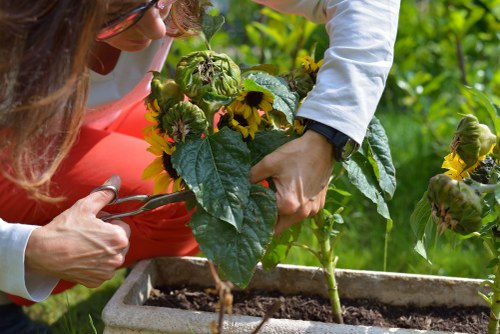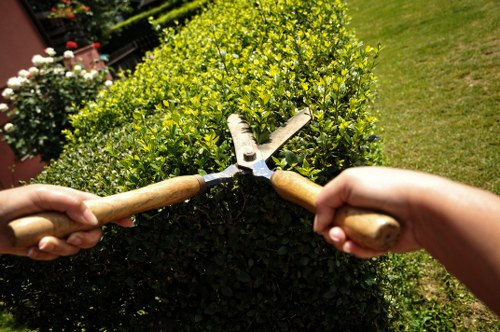Comprehensive Tree Cutting Services in Reading

Maintaining the health and safety of your property often requires professional tree cutting services. In Reading, homeowners and businesses alike can benefit from expert arborists who ensure that trees are properly managed. Whether it's for aesthetic reasons, safety concerns, or property maintenance, tree cutting services play a crucial role in the local community.
Tree cutting is not just about removing trees; it's about understanding the ecosystem and making informed decisions that benefit both the environment and the property owner. Professional services in Reading are equipped with the knowledge and tools necessary to handle a variety of tree-related issues.
Choosing the right tree cutting service involves considering several factors, including experience, safety measures, and customer reviews. In Reading, numerous companies offer these services, each with its unique strengths and specializations.
Why Tree Cutting is Essential

Tree cutting is a vital aspect of property maintenance. It helps in preventing potential hazards such as falling branches, especially during storms or high winds. Regular tree maintenance ensures that trees do not become too large or unwieldy, reducing the risk of damage to your property.
Additionally, proper tree cutting can promote healthier growth. By removing dead or diseased branches, you encourage the tree to focus its energy on producing new, healthy growth. This not only enhances the tree's appearance but also extends its lifespan.
From an aesthetic standpoint, well-maintained trees contribute significantly to the beauty of your property. They provide shade, improve air quality, and add to the overall landscape design. Professional tree cutting ensures that your trees are shaped and maintained to enhance your property's curb appeal.
Services Offered by Tree Cutting Professionals

Tree cutting services encompass a wide range of activities tailored to meet the specific needs of clients. Some of the primary services include:
- Tree Removal: Safe and efficient removal of trees that are dead, dying, or posing a threat to the property.
- Pruning: Trimming and shaping trees to promote healthy growth and improve their appearance.
- Stump Grinding: Eliminating tree stumps to prevent tripping hazards and improve the aesthetics of your yard.
- Cabling and Bracing: Providing support to weak branches to prevent future damage.
- Emergency Tree Services: Immediate response to storm damage or other urgent tree-related issues.
Each of these services requires specialized knowledge and equipment to ensure that the job is done safely and effectively. Professionals in Reading are trained to handle these tasks with precision and care.
Choosing the Right Tree Cutting Service

Selecting a reputable tree cutting service in Reading involves several considerations:
- Experience: Look for companies with a proven track record and extensive experience in tree cutting.
- Licensing and Insurance: Ensure that the service provider is properly licensed and insured to protect against any liabilities.
- Customer Reviews: Read testimonials and reviews to gauge the quality of service and customer satisfaction.
- Safety Standards: The company should adhere to strict safety protocols to ensure the safety of both their workers and your property.
- Range of Services: Choose a provider that offers a comprehensive range of services to meet all your tree-related needs.
By carefully evaluating these factors, you can select a tree cutting service that aligns with your specific requirements and expectations.
Benefits of Professional Tree Cutting Services

Hiring professional tree cutting services offers numerous advantages:
- Safety: Professionals have the expertise and equipment to safely remove trees without causing damage to property or injury to individuals.
- Healthier Trees: Regular maintenance by experts ensures that trees remain healthy and vibrant.
- Time and Efficiency: Experienced arborists can complete tree cutting tasks quickly and efficiently, saving you time and effort.
- Enhanced Curb Appeal: Well-maintained trees enhance the overall look of your property, increasing its value and appeal.
- Environmental Benefits: Proper tree management supports local ecosystems and contributes to better air quality.
These benefits highlight the importance of investing in professional tree cutting services. They not only protect your property but also contribute to the well-being of your surroundings.
Understanding the Tree Cutting Process
The tree cutting process involves several key steps to ensure that the job is done correctly and safely:
- Assessment: The arborist conducts a thorough assessment of the tree and the surrounding area to determine the best approach.
- Planning: A detailed plan is developed, outlining the steps and methods to be used during the tree cutting process.
- Execution: The actual cutting is carried out using specialized tools and techniques to minimize impact on the property.
- Cleanup: All debris is removed, and the site is cleaned to ensure that there are no leftover hazards.
- Follow-Up: In some cases, additional care may be required to support the health of remaining trees.
Each step is crucial to ensure that the tree cutting is done efficiently and without unnecessary complications.
Tools and Equipment Used
Professional tree cutting services utilize a variety of tools and equipment to perform their tasks effectively:
- Chainsaws: Essential for cutting through thick branches and trunks.
- Loppers and Pruners: Used for trimming smaller branches and shaping the tree.
- Aerial Lifts: Allow workers to reach high branches safely and efficiently.
- Stump Grinders: Specialized machines used to grind down tree stumps to ground level.
- Safety Gear: Includes helmets, gloves, harnesses, and other protective equipment to ensure worker safety.
The right tools and equipment not only make the process more efficient but also enhance safety for the workers and the property owner.
Cost of Tree Cutting Services
The cost of tree cutting services in Reading can vary based on several factors:
- Size and Type of Tree: Larger trees or those with complex structures may require more labor and specialized equipment, increasing the cost.
- Location: Trees located in hard-to-reach areas or near structures may require additional effort, affecting the price.
- Condition of the Tree: Diseased or damaged trees may pose greater risks and require more careful handling.
- Additional Services: Services such as stump grinding, debris removal, or emergency response may incur extra charges.
- Accessibility: Easy access to the tree can reduce labor costs, while difficult access can increase them.
It's advisable to obtain multiple quotes from different service providers to compare prices and ensure that you're getting a fair deal for the services you need.
Factors Affecting Pricing
Several elements can influence the overall cost of tree cutting services:
- Tree Height: Taller trees require more resources and specialized equipment, leading to higher costs.
- Branch Density: Trees with dense branching structures may take longer to cut, increasing labor costs.
- Proximity to Structures: Trees near buildings or power lines require careful handling, which can add to the price.
- Seasonal Demand: Prices may fluctuate based on the time of year and the demand for tree cutting services.
- Local Regulations: Compliance with local ordinances and obtaining necessary permits can affect the overall cost.
Understanding these factors can help you anticipate the potential costs involved in tree cutting services.
Safety Measures in Tree Cutting
Safety is a paramount concern in tree cutting operations. Professional services in Reading adhere to strict safety protocols to protect both their workers and your property:
- Personal Protective Equipment (PPE): Workers wear helmets, gloves, eye protection, and harnesses to minimize the risk of injury.
- Proper Training: Arborists are trained in safe tree cutting techniques and are knowledgeable about handling various scenarios.
- Equipment Maintenance: Regular maintenance of tools and machinery ensures they are in good working condition, reducing the likelihood of accidents.
- Safety Protocols: Clear procedures are in place for handling emergencies and unexpected challenges during the tree cutting process.
- Site Inspection: Before starting, the area is inspected to identify any potential hazards and to plan the safest approach.
By prioritizing safety, tree cutting services ensure that the work is completed without accidents or damage.
Environmental Considerations
Professional tree cutting services take environmental factors into account to maintain ecological balance:
- Sustainable Practices: Companies strive to use methods that minimize environmental impact, such as recycling wood and reducing waste.
- Ecosystem Preservation: Efforts are made to preserve surrounding flora and fauna during tree cutting operations.
- Tree Health: Proper pruning and maintenance encourage the health of remaining trees, supporting local biodiversity.
- Legal Compliance: Adhering to local environmental regulations ensures that tree cutting is performed responsibly.
These considerations help in protecting the environment while providing essential tree management services.
Local Expertise in Reading
Tree cutting services in Reading are well-versed in the local climate, tree species, and community needs. This local expertise ensures that the services provided are tailored to the specific conditions and requirements of the area.
Understanding the unique challenges of the Reading area, such as weather patterns and common tree diseases, allows professionals to offer more effective solutions. This knowledge also contributes to better planning and execution of tree cutting projects.
Moreover, local companies are more likely to be familiar with regional regulations and permits required for tree cutting, ensuring that all legal aspects are properly handled.
Community Involvement
Many tree cutting services in Reading are actively involved in the community. They participate in local events, support environmental initiatives, and contribute to the preservation of the area's natural beauty. This involvement fosters trust and strengthens their reputation as reliable and responsible service providers.
- Educational Programs: Some companies offer workshops and seminars to educate homeowners about tree care and maintenance.
- Environmental Projects: Participation in tree planting and conservation projects helps in maintaining the local ecosystem.
- Local Partnerships: Collaborations with other local businesses and organizations enhance their service offerings and community presence.
Such initiatives demonstrate a commitment to not just business growth but also to the well-being of the community and environment.
10-15 Nearby Areas to Reading for Tree Cutting Services
Beyond Reading, several nearby areas can benefit from professional tree cutting services. Each of these areas has its unique characteristics that influence the demand and type of services required:
- Wokingham: Just south of Reading, Wokingham boasts a mix of residential and commercial properties that often require expert tree maintenance.
- Tilehurst: A suburb of Reading known for its spacious gardens and large trees, making tree cutting services essential for homeowners.
- Earley: With its growing residential areas, Earley sees a steady demand for tree pruning and removal services.
- South Oxfordshire: This rural area near Reading has vast green spaces and estates that require regular tree management.
- Maidenhead: Close to Reading, Maidenhead's urban landscape integrates trees that need careful maintenance to coexist with city infrastructure.
- Bracknell: An industrial hub near Reading, Bracknell benefits from tree cutting services to maintain green spaces around business districts.
- Newbury: Known for its historic sites and lush greenery, Newbury requires sensitive tree cutting services that preserve the area's natural beauty.
- Henley-on-Thames: With its riverside properties, tree cutting services here focus on maintaining trees that enhance the scenic views.
- Woodley: A residential area in Reading that frequently requires tree removal and pruning to ensure safe and attractive homes.
- Sonning: This picturesque village near Reading favors eco-friendly tree cutting practices to preserve its charm.
- Emmer Green: A quiet suburb where tree cutting services help in maintaining the area's peaceful and green environment.
- Caversham: Adjacent to Reading, Caversham's blend of urban and natural landscapes relies on professional tree maintenance.
- Leighton: A small community near Reading that benefits from affordable and reliable tree cutting services.
- Katesgrove: With its diverse flora, Katesgrove requires experts to manage various tree species effectively.
- Whitley: A growing area where tree cutting services are crucial for new developments and existing properties.
- Mortimer: Known for its natural beauty, Mortimer relies on professional arborists to maintain its landscape.
How to Prepare for Tree Cutting
Proper preparation can enhance the efficiency and safety of the tree cutting process. Here are some steps to help you prepare:
- Clear the Area: Remove any obstacles around the tree to provide clear access for the arborists and machinery.
- Communicate Your Needs: Clearly explain what you expect from the tree cutting service, including any specific concerns or requirements.
- Check for Utilities: Ensure that there are no underground or overhead utilities that could be affected during the tree cutting process.
- Obtain Necessary Permits: Some tree cutting activities may require permits from local authorities. Verify and secure them in advance.
- Protect Nearby Structures: Use protective barriers or coverings to safeguard nearby buildings, vehicles, and other property from potential debris.
By following these steps, you can facilitate a smoother and more effective tree cutting operation.
Post-Cutting Care
After the tree cutting process, certain measures can help maintain the health of your remaining trees and property:
- Remove Debris: Ensure that all branches, leaves, and other debris are properly disposed of or recycled.
- Inspect the Area: Check the site for any potential hazards or damages that may need immediate attention.
- Water and Fertilize: Providing adequate water and nutrients to remaining trees can support their recovery and growth.
- Monitor Tree Health: Keep an eye on the health of your trees for any signs of disease or stress, and address issues promptly.
- Consult an Arborist: If you're uncertain about the condition of your trees, seek professional advice to ensure their optimal health.
These post-cutting care steps contribute to the long-term well-being of your trees and property.
Environmental Impact of Tree Cutting
Tree cutting, when done responsibly, can have a positive impact on the environment. Sustainable practices ensure that the benefits of tree cutting are maximized while minimizing any negative effects:
- Promoting Biodiversity: Removing unhealthy trees can create space for new growth, supporting diverse plant and animal species.
- Carbon Sequestration: Healthy trees absorb carbon dioxide, helping to mitigate climate change.
- Soil Health: Proper tree management prevents soil erosion and maintains soil fertility.
- Water Management: Trees play a crucial role in managing water runoff and maintaining water quality.
- Air Quality: Trees filter pollutants from the air, contributing to cleaner and healthier environments.
By adhering to environmentally friendly practices, tree cutting services can support ecological sustainability and enhance the natural beauty of the area.
Recycling and Reuse
Many tree cutting services prioritize recycling and reusing wood and other materials:
- Firewood Sales: Cut wood can be processed and sold as firewood, providing a renewable energy source.
- Mulching: Wood chips and mulch improve soil quality and support plant growth.
- Lumber Recycling: Salvaged wood can be repurposed for construction, furniture, or other creative projects.
- Composting: Organic debris can be composted to enrich the soil.
- Donation: Some businesses donate wood to local organizations or community projects.
These practices reduce waste and promote the efficient use of resources, benefiting both the environment and the community.
Seasonal Considerations for Tree Cutting
Different seasons present unique challenges and opportunities for tree cutting services. Understanding these seasonal factors can help in planning and executing effective tree maintenance:
- Spring: Ideal for planting new trees and performing pruning before the growing season begins.
- Summer: Suitable for maintenance tasks and addressing any storm damage that may have occurred.
- Autumn: Perfect for clearing fallen leaves and preparing trees for winter by removing weak branches.
- Winter: Best for removing dead or damaged trees when they are dormant, reducing the risk of disease and pests.
Seasonal tree cutting ensures that trees remain healthy and that any potential issues are addressed promptly and effectively.
Weather Impact
Weather conditions significantly influence tree cutting activities:
- Wind: High winds can make tree cutting hazardous, requiring careful planning and execution.
- Rain: Wet conditions can make surfaces slippery and increase the risk of accidents.
- Temperature: Extremely cold or hot temperatures can affect both the workers and the trees being cut.
- Storms: After a storm, tree cutting services are in high demand to remove fallen or damaged trees.
- Humidity: High humidity levels can impact the drying and curing of wood after cutting.
Professional services are equipped to handle various weather conditions, ensuring that tree cutting is performed safely and effectively year-round.
Regulations and Permits
Tree cutting is subject to local regulations and may require specific permits. Understanding and complying with these rules is essential to avoid fines and ensure that tree cutting is performed legally:
- Consent for Protected Trees: Some trees are protected by local ordinances, and their removal may require special permission.
- Permits for Large Tree Removal: Removing large or significant trees may necessitate obtaining a permit from the local council.
- Environmental Regulations: Compliance with environmental laws ensures that tree cutting does not negatively impact the ecosystem.
- Zoning Laws: Regulations that dictate where and how trees can be cut based on the property's zoning classification.
- Fines and Penalties: Non-compliance with regulations can result in substantial fines and legal consequences.
Working with a professional tree cutting service ensures that all regulatory requirements are met, preventing any legal issues and promoting responsible tree management.
Obtaining Necessary Permits
Securing the right permits is a critical step in the tree cutting process:
- Research Local Requirements: Each area may have different rules regarding tree cutting. Check with the local council or municipality for specific guidelines.
- Application Process: Complete any required applications and provide necessary documentation, such as tree assessments or site plans.
- Timelines: Permit approval times can vary, so plan accordingly to avoid delays in your tree cutting project.
- Fees: Be prepared to pay any associated fees for obtaining permits.
- Professional Assistance: Many tree cutting services offer help with the permit application process, ensuring compliance and reducing your workload.
Having the correct permits not only ensures legal compliance but also supports environmentally responsible tree management.
Choosing Sustainable Tree Cutting Practices
Sustainability in tree cutting involves practices that support environmental health and resource conservation:
- Selective Cutting: Removing only certain trees to maintain the overall health of the forest or landscape.
- Replanting: Planting new trees to replace those that have been cut, ensuring ongoing forest regeneration.
- Minimizing Waste: Using as much of the cut tree as possible, either through recycling or repurposing.
- Energy-Efficient Equipment: Utilizing tools and machinery that consume less energy and produce fewer emissions.
- Eco-Friendly Disposal: Properly disposing of tree waste to prevent pollution and support recycling efforts.
Adopting sustainable practices ensures that tree cutting contributes positively to the environment and supports long-term ecological balance.
Impact on Local Wildlife
Tree cutting can have significant effects on local wildlife. Professional services take measures to minimize disruptions to animal habitats:
- Timely Cutting: Performing tree cutting during seasons when wildlife is less active reduces the impact on animal populations.
- Habitat Preservation: Retaining certain trees and maintaining natural corridors supports the movement and survival of local species.
- Noise Control: Limiting noise levels during operations helps prevent stressing nearby wildlife.
- Post-Cutting Restoration: Replanting and habitat restoration efforts support the recovery of ecosystems after tree cutting.
- Consultation with Experts: Working with environmental specialists to ensure that tree cutting aligns with wildlife conservation goals.
These efforts help maintain the delicate balance between development and wildlife preservation.
Innovations in Tree Cutting Technology
The tree cutting industry continually evolves with advancements in technology, enhancing efficiency and safety:
- Advanced Chainsaws: Modern chainsaws are more powerful, efficient, and safer, reducing the risk of accidents.
- Aerial Drones: Used for inspecting trees and planning cutting strategies without putting workers at risk.
- Stump Grinders: Improved designs enable faster and more effective removal of stumps, minimizing disruption.
- Safety Harnesses and Rigging Systems: Enhanced equipment ensures better support and protection for workers during high-elevation cuts.
- Software Solutions: Project management and planning software help arborists organize and execute tree cutting tasks more efficiently.
These technological innovations contribute to safer, faster, and more environmentally friendly tree cutting practices.
Eco-Friendly Tools and Practices
Emphasizing eco-friendliness, many tree cutting services adopt green tools and sustainable practices:
- Electric Chainsaws: Reduce carbon emissions compared to traditional gas-powered models.
- Biodegradable Lubricants: Used to minimize environmental contamination during tree cutting.
- Solar-Powered Equipment: Harness renewable energy sources to power tools and machinery.
- Recycling Programs: Implementing systems to recycle wood and other materials effectively.
- Green Certifications: Obtaining eco-friendly certifications to demonstrate commitment to environmental responsibility.
Adopting these eco-friendly tools and practices supports sustainable tree management and reduces the environmental footprint of tree cutting operations.
Conclusion
Tree cutting services in Reading offer essential benefits for property maintenance, safety, and environmental health. By choosing professional and sustainable practices, residents and businesses can ensure that their trees are well-managed and their properties remain attractive and safe.
Understanding the various aspects of tree cutting—from the services offered and costs involved to safety measures and environmental considerations—empowers you to make informed decisions. Whether you're in Reading or one of its nearby areas, investing in expert tree cutting services is a valuable step towards maintaining a healthy and beautiful landscape.
Remember to consider local expertise, regulatory compliance, and sustainable practices when selecting a tree cutting service. With the right partner, you can enjoy the numerous benefits that well-maintained trees bring to your property and community.
Frequently Asked Questions
1. When is the best time of year to get trees cut down?
The best time for tree cutting is during the dormant season, typically in late fall or winter. This minimizes stress on the tree and reduces the risk of disease and pests. However, some situations may require tree removal at any time, especially if the tree poses an immediate risk.
2. How much does tree cutting service cost in Reading?
The cost varies depending on factors such as the size and type of the tree, its location, and the complexity of the job. On average, prices can range from £150 to £1,500. It's best to obtain multiple quotes from local services to get an accurate estimate.
3. Do I need a permit to cut down a tree in Reading?
It depends on the type and location of the tree. Protected trees or those in certain areas may require permits from the local council. Professional tree cutting services can assist in determining if a permit is needed and help with the application process.
4. Can tree cutting improve the health of my trees?
Yes, regular pruning and removal of dead or diseased branches can significantly improve the overall health of your trees. It helps prevent the spread of pests and diseases and promotes vigorous growth.
5. How do I choose the right tree cutting service in Reading?
Look for experienced, licensed, and insured professionals with positive customer reviews. Consider the range of services they offer, their safety standards, and their commitment to sustainable practices. Obtaining multiple quotes and asking for references can also help you make an informed decision.

